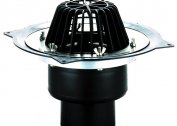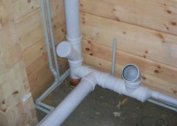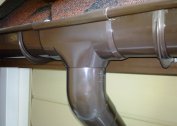When the water in the sink stops draining, then there is a blockage somewhere. Most often this place is just a siphon. You can fix the problem yourself if you have at hand a similar step-by-step guide.
What is a siphon and why is it needed
 Siphon is one of the main elements of the drainage complex in any modern residential building, apartment or building where there is a sewage system. Its main and only task is to protect the sewer from clogging, at the moment of passing through itself water that enters there from a source (filter, mixer, etc.).
Siphon is one of the main elements of the drainage complex in any modern residential building, apartment or building where there is a sewage system. Its main and only task is to protect the sewer from clogging, at the moment of passing through itself water that enters there from a source (filter, mixer, etc.).
In order for the siphon to effectively cope with the function of water drainage, before purchasing it, you must first calculate the load with which it must cope.
Siphon device and principle of operation
On the shelves of shops with plumbing, you can find a large number of different types of siphons, which can be divided into groups at their place of use for:
- a garage;
- sinks;
- kitchens (for a washing machine);
- bathtubs;
- a washing machine;
- bathroom;
- shower cabin ("gangway").
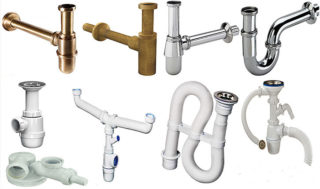 Regardless of the place of application, siphons are also divided according to their design features:
Regardless of the place of application, siphons are also divided according to their design features:
- corrugated;
- bottle;
- pipe.
Pipe and bottle models can be attached to any equipment. As for the corrugated models, it is better not to use them in the kitchen, due to the fact that they become soiled very quickly and often require cleaning.
There are also flat siphons that are relevant for shower trays or other places where the connection is made in a limited space.
Siphons can be equipped with additional taps to connect several devices or devices, as well as an overflow system that protects the siphon from overflow.
Corrugated Siphons
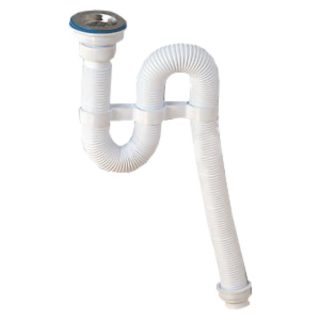 This is the simplest design option, so this option costs less than the rest. At the heart of the device is a corrugated pipe that can be bent as you wish.
This is the simplest design option, so this option costs less than the rest. At the heart of the device is a corrugated pipe that can be bent as you wish.
To connect to a sink or other plumbing equipment, there is an upper compartment that has a drain grill, and a bolt with a clamping nut for fastening. Such models are not equipped with overflow or additional nozzles.
Bottle Siphons
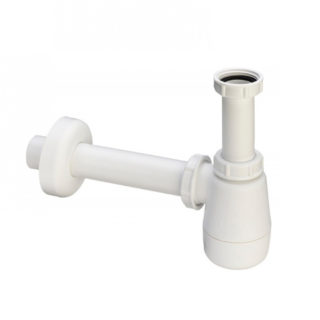 May also be referred to as flask. The device of such a siphon includes:
May also be referred to as flask. The device of such a siphon includes:
- The pipe that is required to attach the siphon.
- Branch (outlet branch pipe), which is connected to the sewer.
- The flask that represents the siphon tank.
- Clamping nuts, which are required to assemble the structure.
- O-rings
The operation of this type of siphon is as follows. A certain amount of water accumulates in the flask, which creates a water lock. Among other things, large particles of garbage also accumulate in the bottle.
These types of siphons are easiest to clean, so they are the most popular. To clean it, just disconnect the outlet pipe.
Pipe siphons
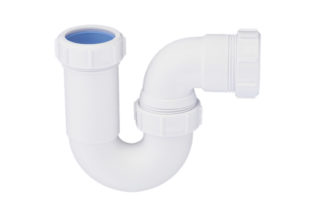 Such a siphon consists of the following elements:
Such a siphon consists of the following elements:
- The top element that is installed on the sink, bathtub or sink. Mounting occurs using a special bolt.
- The middle element is a rigid pipe of shape S or U.
- The bottom element for the outlet to the sewer.
All modern siphon options are separated by the method of work:
- Automatic
- semi-automatic;
- tame.
Automatic
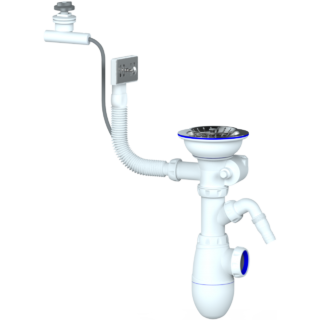 Thanks to the additional automation, which is equipped with a siphon, the equipment independently regulates the water level in the plumbing device. There are 2 types of automatic options:
Thanks to the additional automation, which is equipped with a siphon, the equipment independently regulates the water level in the plumbing device. There are 2 types of automatic options:
- with handle to open the cork;
- siphons with a click-clack device, when the drain cap is mounted on a special pin, which is activated with one click.
Semi-automatic
This type of siphon is equipped with a device that prevents the smell from spreading through the room. Among the distinctive design features, the following can be noted:
- the cable moves the drain cover;
- to activate the movement of the cable, you must use the handle that is on the overflow hole.
Convenience is that to activate the drain cover there is no need to wet your hands in water.
Hand siphons
This version of the siphon is maximally simplified. The drain cover is separate and in order to initiate water drain, you only need to remove it from the hole. To fill with water, the hole must be closed. The cover can be held separately or attached using a chain to the overflow compartment.
Siphon cleaning without disassembling or removing
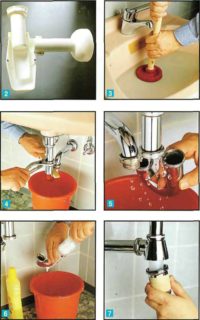 To clean the siphon without disassembling, several options can be used simultaneously:
To clean the siphon without disassembling, several options can be used simultaneously:
- hydraulic pump;
- plunger;
- plumbing cable;
- soda;
- chemistry.
Hydraulic pump cleaning
The hydraulic pump is able to cope with fairly dense and strong blockages. The cleaning process is carried out using water, which is supplied under high pressure, so that it is possible to clean the blockage. The principle of operation is as follows:
- Water is pumped into the pump and attached to the drain hole.
- Several pressures of water occur under pressure and the blockage is removed.
Plunger cleaning
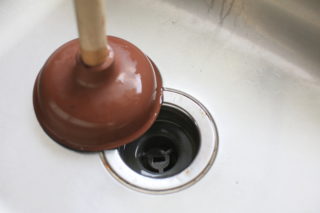 This is a “simplified” version of the hydraulic pump, which operates in manual mode and can be used not only for cleaning siphons, but also for sewer pipes. Its device is as simple as possible and consists only in the presence of a wooden handle and a rubber lining.
This is a “simplified” version of the hydraulic pump, which operates in manual mode and can be used not only for cleaning siphons, but also for sewer pipes. Its device is as simple as possible and consists only in the presence of a wooden handle and a rubber lining.
Use a plunger as follows:
- A small amount of hot water must be drawn into the bath or sink.
- The rubber pad of the plunger must close the drain hole.
- After several continuous presses on the handle, it is necessary to tear off the rubber nozzle from the hole.
Thanks to such movements, pressure is created in the drainage system, which destroys the blockage into smaller fractions and allows them to pass further into the sewer.
This is the very first manual method that should be resorted to in case of blockage.
Use of soda
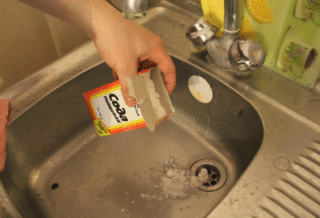 A mixture of ordinary baking soda with salt and vinegar is also able to clean the blockage. Thanks to the chemical reaction of the mixed ingredients, they corrode the blockage from organic residues. To use this method, you must follow the following instructions:
A mixture of ordinary baking soda with salt and vinegar is also able to clean the blockage. Thanks to the chemical reaction of the mixed ingredients, they corrode the blockage from organic residues. To use this method, you must follow the following instructions:
- Mix half a glass of vinegar with the same amount of soda.
- Pour into the drain and cover it with cling film.
- Wait 30-40 minutes.
- Clean with hot water.
In the same proportions, salt and soda can be used, but after falling asleep the mixture in the drain, it is necessary to fill it with a glass of boiling water.
Chemistry use
Modern chemicals like Mr. Muscle, Tyreth, or Mole can quickly deal with blockages. The process is almost the same, but it must be borne in mind that the tool must be selected based on the type of pipe.
Almost all of them are used according to the following instructions:
- The product is poured / poured into the drain.
- Withstands a certain time.
- It is washed with warm water.
It is very important to comply with all safety standards when working with such tools and clearly follow instructions.
Cleaning with a plumbing cable
If none of the above means helped, then you need to go to the radical method - cleaning with a plumbing cable. You can do it yourself or call the plumbing:
- The cable is gradually inserted into the drain hole.
- With the help of circular motions, blockage is eliminated.
Cleaning with siphon disassembly
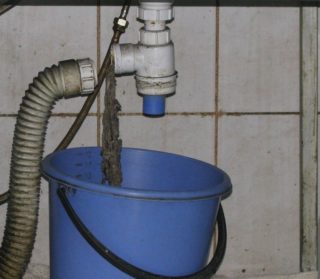 If cleaning does not work indiscriminately, then you should disassemble the siphon to clean it and return it to its place. The procedure is as follows:
If cleaning does not work indiscriminately, then you should disassemble the siphon to clean it and return it to its place. The procedure is as follows:
- Under the siphon, you need to install a bucket so that water is poured into it.
- We turn off the siphon sump, where all the small and large elements fall.
- Remove the blockage from the sump.
- Carefully inspect the siphon for accumulation of a large amount of fat, then you can finish the cleaning. If there is a large accumulation of fatty deposits on the walls, it is recommended to clean it with special chemical detergents.
- It remains only to put the sump in place and tighten the siphon back. After checking, you can continue to use the drainage system.
When reassembling, it is very important to ensure that the gasket on the sump settles in place to avoid leakage.
